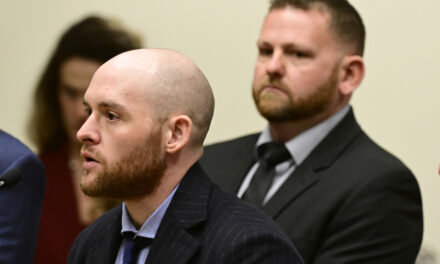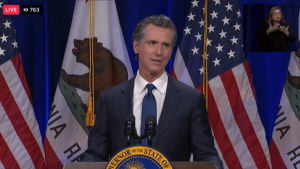By Frank Dexter Brown,
Special to the AFRO
What a year of global weather-related events it was in 2022, and now into 2023.
The extreme weather witnessed during the summertime and fall of 2022 were soon followed by devastating weather conditions this winter. Historic freezing temperatures caused by what meteorologists referenced as “arctic blasts,” spread through the North, Midwest, and Northeast. The city of Buffalo, N.Y. especially, had unprecedented snowfall—80 inches over four days. Residents were stuck in homes for days; some were caught outdoors and froze—in total, 47 people lost their lives. They were disproportionately Black.
Today, such extreme winter events have carried into Spring 2023, as unprecedented heavy snowfall and rainfall, often caused by what Californians have come to know as “atmospheric rivers,” have resulted in heavily damaged cities, towns and communities—and again, millions in financial losses.
And, most recently, we’ve witnessed the beginning of a tremendously violent tornado season, bringing death and destruction throughout the U.S.—the Midwest and South most notably. Consider March 25: the pain, the suffering, the shock, when 98 percent of the communities in the towns of Rolling Fork and Silver City, Miss., were gone.
For about 1,800 mostly Black residents, the landscape for miles looked as if bombs had blanketed the area. For as far as the eye could see, all was turned to ruin —homes were left as rubble, buildings were collapsed, and trees had been ripped from roots and splintered. Twenty-five people were killed. Some residents—dead and alive—were found trapped inside cars, houses and cherished community landmarks, including a church and community center.
The tornado system that ripped through the area is said to have had sustained winds as high as 200 miles an hour and spanned 170 miles, while lasting for more than an hour. It was the most powerful and longest lasting tornado system ever recorded in Mississippi.
As reported in Part One of this series, these severe weather upheavals such as those referenced above, are occurring with greater frequency and severity globally. Extreme weather can be expected to become more pervasive.
This week, we turn to other climate-change studies in order to assess and specifically focus on the United States. Here we report on what must be done in the United States to mitigate the increased dangers resulting from the increase in greenhouse gas (GHG) emissions. We also explore the economic impact of extreme weather events on U.S. communities.

The heat is on: the haunting consequences of not responding to warming caused by fossil fuels
The findings were clear as the title of the United Nations report, “The Heat is On: A World of Climate Promises Not Yet Delivered”: “With climate change intensifying and scientists warning that humanity is running out of time to limit global warming to 1.5 degrees Celsius over pre-industrial levels, 2021 has been a fraught year for the planet.”
“The Heat is On,” also known as “The Emissions Gap Report 2021,” was released Oct. 26, 2021, just as the United Nations Framework Convention on Climate Change (UNFCCC) COP 26 was gathering in Glasgow, Scotland.
Produced by an international group that includes 78 scientists from 44 institutions across 24 countries, “The Heat is On” is the 12th edition in the annual Emissions Gap Report series of the United Nations Environment Programme (UNEP). The report provides a year-by-year overview of the difference between where greenhouse gas emissions—primarily carbon dioxide, methane, and nitrous oxide—are predicted to be in 2030. The report also stated where the emissions need to be to avert the worst impacts of climate change.
This renowned group of scientists, economists and other technical experts were explicit in illuminating what the data show.
They wrote: “National climate pledges combined with other mitigation measures put the world on track for a global temperature of 2.7 degrees Celsius by the end of the century. That is well above the goals of the [2015] Paris climate agreement and would lead to catastrophic changes in the Earth’s climate.”
They experts were saying in late 2021, that we– human beings on Planet Earth– have less than a decade to get things in order. In other words, the next eight years (now seven) will determine how the world needs to proceed over the next eighty years and beyond.
“To keep global warming below 1.5 degrees Celsius this century—the aspirational goal of the Paris Agreement,” they warned, “the world needs to halve annual greenhouse gas emissions in the next eight years [by 2030].
“The emissions gap,” as determined by scientists, is an assessment of the increasing “difference from where we will likely be to where we need to be.”
Because the emissions gap is growing, the scientists reported average temperatures were on track to rise by 3.2 degree Celsius above pre industrial levels—a rise in temperatures that is dangerous to all life on Earth, they say. “There is a fifty-fifty chance that global warming will exceed 1.5 degrees Celsius in the next two decades, and unless there are immediate, rapid and large-scale reductions in GHG emissions, limiting warming to 1.5 degrees Celsius or even 2 degrees Celsius [3.6 degrees Fahrenheit] by the end of the century, will be beyond reach.”
The consequences of not doing so will indeed be disastrous, they write, as extreme weather catastrophes have escalated globally: overwhelming heat can be linked to historic rainfall and wind events—hurricanes, tornadoes, typhoons, cyclones, monsoons—causing flash floods, mudslides and other weather-related disasters to inundate and pound neighborhoods and entire communities in regions globally.
While severe dryness and wildfires have swept through worldwide regions as well, resulting in harsh droughts, failing agriculture, food shortages and famine across many regions, ocean temperatures are increasing precipitously, with oceans growing more acidic, and coral reefs — “the Amazons of the sea”— bleaching (dying), as sea life is endangered, even becoming extinct.

Pathways to Paris: a policy-focused assessment of the 2030 U.S. climate target
Here in the U.S., there is critical additional research needed to understand the road we must be prepared to travel.
In particular, “Pathways to Paris: A Policy Assessment of the 2030 U.S. Climate Target,” speaks directly to U.S.-stated emission goals, and what is needed to achieve those objectives.
These researchers, as with those of the IPCC and UNEP, also are quite frank. Without immediate change in global fossil fuel policies—policies that must be led by U.S. institutions (federal, state and local governments and businesses) in reducing fossil fuel-usage, and production, as well as oil industry subsidy-financing—worldwide extreme weather disasters can only be expected to escalate.
“… impacts of climate change have become more immediate and tangible. A cascade of natural disasters — floods, hurricanes, wildfires, droughts, and extreme heat — have touched nearly every corner of the U.S.,” says the report published by Rhodium Group, an independent research institution that combines economic data, and policy insight, to analyze global trends.
“It’s clearer than ever that the planet is on track for even more intense impacts in the decades ahead if action isn’t taken soon to avoid the worst climate damages.”
Unequivocally, “Pathways to Paris: A Policy Assessment of the 2030 U.S. Climate Target,” is direct about the dangers that await. Most significantly, “Pathways to Paris” stresses the leadership role that the United States must play.
“While the challenge of closing the gap is daunting, achieving the target is in line with what’s required to avoid the worst impacts of climate change. Not following through on this commitment risks undermining the credibility of the U.S. and reduces the chances of an ambitious multilateral response to climate change.”
As noted in the subtitle — “A Policy Assessment of the 2030 U.S. Climate Target” — “Pathways to Paris” is an appraisal, a review, of U.S. pledges to reduce usage of fossil fuels and overall production of greenhouse gas emissions, and which features scenarios and modeling.
Can the U.S. be trusted to meet its climate promises and responsibilities?
Researchers emphasize that the global push to cut CO2 emissions must be driven by the U.S.
Two months into the start of the Biden administration, it submitted the U.S. economy-wide NDC emissions reduction target. The Biden Administration said that they were aiming to be 50-52 percent below 2005 emissions levels in 2030.
That’s right, a target that’s now only seven years away.
As titled, “Pathways to Paris” assesses that target and reviews the path to achieving it.
“There is much more than the future of U.S. emissions at stake,” the researchers write, adding, “The announcement of an ambitious 50-52 percent goal was a welcome signal to the rest of the world that the US [under the Biden administration] has serious intentions to be part of a net-zero future.”
“But good intentions only go so far. America’s international partners will need to see clear, concrete steps to implement that goal — in the form of policies and funding — for them to trust that the US can walk the talk.”
The stated U.S. NDC path should be embraced by broad U.S. groups and institutions, “Pathways to Paris” says. Leading the way in cutting emissions, the experts say, is overwhelmingly a U.S. responsibility. This is what some have argued for decades — as the world’s largest emitter historically (largest annual emitter until 2006) and the nation responsible for the greatest amount of accumulated carbon emissions in the atmosphere, it’s only proper that the U.S. must lead in worldwide reductions, these experts say.
(Note: China became the world’s largest annual emitter in 2006 as it grew to become the world’s leading manufacturer of consumer goods and industrial products—disproportionately shipped to the U.S., European Union and other G20 states—the U.S. is now the world’s second largest annual emitter).
Needless to say, nations and regions worldwide are involved in emissions reduction negotiations, and the application of mitigation policies as they grapple with deadly weather upheavals.
An independent, objective and policy-focused assessment of the U.S. 2030 target
“Pathways to Paris,” the researchers say, seeks to answer a pair of crucial questions: “This report aims to provide an independent, objective, and policy-focused assessment of the U.S. 2030 target.
We combine our knowledge of the U.S. economy, energy systems and policy design with state-of-the-art modeling tools to comprehensively answer two questions: Can the U.S. cut net GHG emissions by 50-52 percent by 2030 and if so, what does a policy pathway to the target look like?”
Rhodium Group, an organization that does public policy research, reports that the America must lead in “actions by all key actors in the U.S. federal system, including legislation under construction in Congress, regulations and other actions that can be taken by the Biden administration…”
“Pathways to Paris” adds how “the suite of policies we consider is not intended to be exhaustive.
Instead, it represents a series of actions that can be reasonably expected to occur over the next nine years [to 2030] if leaders in all levels of government work in earnest to address climate change.”
Rhodium: The U.S. should lead via a series of practical and feasible policy actions
So, what does a policy pathway to the climate target look like today?
For now, in part, it takes the form of legislation like the Inflation Reduction Act of 2022—the unexpected reconciliation budget agreement that Senate Majority Leader Chuck Schumer (D-N.Y.) and Sen. Joseph Manchin (D-W.Va.) announced July 27, 2022.
It included an estimated $369 billion in climate initiatives and taxes (a more comprehensive bill, closer to Biden’s original “Build, Back Better” measure, had been rejected by Manchin days and months earlier).
Climate elements that passed as part of the Inflation Reduction Act, many reflecting measures similar to those proposed by Rhodium, include: $60 billion for environmental justice community contamination cases; $27 billion to finance a “green bank” to finance clean energy projects; $20 million for emissions reductions in the agricultural sector; tax credits for solar panel, wind farm, battery, electric vehicle, carbon sequestration and zero-carbon power plant investments.
Importantly, Rhodium’s study added to an understanding of what’s possible, by reporting at the time, if both the infrastructure bill and budget reconciliation package had passed, and then were “coupled with a steady stream of standards and regulations by federal agencies and accelerated action by leading states and companies, that these combined actions could cut U.S. net GHG emissions to 45-51 percent below 2005 levels in 2030,” instead of the earlier cited current path reduction of only 17-25 percent.”
This did not happen.
Nevertheless, the less comprehensive Inflation Reduction Act of 2022 budget reconciliation bill still was an improvement to the limited climate policies of the Trump administration and then-Republican-controlled Senate and House.
The mindset needed to block needed climate legislation still exists in Congress, particularly with the slim Democratic majority in the Senate and Republican-controlled House. Attempts by Biden’s Environmental Protection Agency Administrator Michael S. Regan, a Black man from Louisiana, to tighten regulations and limit toxic power plant emissions have been met with resistance by intransigent Congressional members of both parties and energy-related industries.
Similarly, EPA’s attempts to strengthen the Clean Water Act have also been met with conservative Congressional opposition.
Environmental activists, however, including those of the environmental justice movement, say the rules are crucial in saving Black lives, and those of other people disproportionately impacted by toxic industrial pollution.
Rhodium’s policy prescriptions show the possibilities for saving the world…
“Pathways to Paris” reveals how at each government level, “practical policy actions…can help achieve the target.”
The 2024 U.S. elections are crucial. The Inflation Reduction Act, as mentioned, was just a start, for where researchers say the U.S. must go in reducing CO2 emissions.
Indeed, Manchin and Schumer themselves said in their statement describing their deal, that the bill will cut U.S. net GHG emissions “roughly 40 percent by 2030.”
Experts are calling for a more comprehensive bill to pass, if not before, then following the 2024 elections. If not, the U.S. Paris commitments for 2030, they say, will be in jeopardy.
As “Pathways to Paris” reports, congressional action is critical to achieving the 2030 target for two reasons:
- Lawmakers can pass “Measures in the infrastructure and budget packages can enable and accelerate clean technology deployment and on their own cut emissions significantly.”
- Proper legislation can “reduce consumer and compliance costs of federal and state actions that, combined with congressional actions, put the target within reach.”
If such policy approaches are achieved, the target will be historic, but only halfway to the net-zero finish line.
“Without near-term progress on these fronts in the years ahead, closing the gap to net-zero emissions by 2050 will be more challenging than getting to the 2030 target,” according to the “Pathways to Paris” report.
Editor’s note: Part 3 of this series “Following the Science: Environmental Justice and Climate Justice—A National and Global Movement.”
Frank Dexter Brown, who is a longtime contributor to the AFRO, is the founder and executive director of the Baobab Diaspora Visions project, and earthAfrica media and news service, media institutions that document the dangers of the climate crisis—and how these dangers, while impacting all on Earth, particularly affects those living in Global South states and Global North communities of color.
The post Part two: Following the science: America must lead in meeting clear environmental goals appeared first on AFRO American Newspapers .










